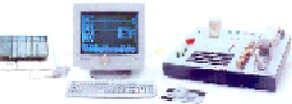| A. Unit Code and Suggested Title: |
CE-998
PLC’s - Introduction to Programmable Logic Controllers
|
| B. Curriculum/Program: |
Computer Repair Technology
|
| C. Catalog Description: |
An introduction to electrical safety, basic electrical circuits and
components associated with PLC’s. The understanding of Schematic
and Ladder diagrams and Input/Output devices is covered. Logic systems
and logic expressions are presented to gain an understanding of PLC programming
basics.
|
D. Number of Class Periods and
... Credit Hours: |
Three 50-minute-per-week classes for 15 weeks (1 hour
of lecture and 2 hours of lab)
2 credit hours
|
| E. Suggested Text(s): |
Programmable Logic Controller
Second Edition / By Frank Petruzella / McGraw Hill Publications
|
| F. Prepared By: |
David F. English, Jr.
|
| G. Program Competencies: |
Upon graduation with an associate in applied science degree in Computer
Repair Technology, the graduate will be able to:
- Use the resistor color code and component recognition.
- Be proficient at electronic soldering and terminating wire connections
using solderless type connectors.
- Use a curve tracer to check all types of diodes, bipolar transistors,
and field effect transistors.
- Demonstrate proficiency in using electronic test instrumentation
dual trace scopes, frequency counters and function generators.
- Be proficient at troubleshooting half-wave, full-wave, bridge power
supplies. In addition, student will be able to troubleshoot and repair
voltage doublers.
- Prototype multistage analog and digital circuits, check these circuits
for normal operation and design and construct circuit boards for these
circuits.
- Design, construct and test digital logic circuits to meet the demands
of any four input logic circuits.
- Understand basic theory and architecture of computer systems.
- Interact with a computer system to assess its performance.
- Disassemble and reassemble mechanical components of computer systems
and adjust for proper operation.
- Isolate system malfunction by relating program execution to specific
groups of circuits.
- Use system software to generate, operate and maintain program logos
to identify failed system components.
- Understand power systems.
- Isolate data communications system faults to specific subsystems.
|
| ... General Education Competencies:
|
- To listen and speak effectively
- To write correctly and effectively
- To apply appropriate mathematical procedures and quantitative methods.
- To identify and logically analyze problems and issues and propose
and evaluate solutions.
|
| H. Course Objectives: |
The student will understand how electrical safety and basic electrical
circuits are used with PLC’s. The student will be able to demonstrate
how schematic and ladder diagrams are used to program Logic controllers.
The student will be able to write and program basic PLC functions.
|
| I. Assessment of Student Learning: |
Minimum of twelve lab reports due - 50 percent
Two comprehensive exams – 50 percent
Exam 1 – at end of week eight
Exam 2 – at end of week fifteen
|
| K. Lecture/Laboratory Outline: |
Topics:
Weeks 1 to 3 – Basic Electrical Concepts
a. Electrical safety
b. Schematic diagrams and symbols
c. Ladder diagrams
d. Input/Output components
e. Relays
Weeks 4 to 7 – Computer Logic and Numbering Systems
a. Binary logic
b. And, or, and not functions
c. Numbering systems
d. Boolean algebra
e. Logic expressions
Weeks 8 to 15 – PLC Programming Basics
a. Memory types
b. Relay type instructions
c. Programming languages
d. Addressing and branch instructions
e. Programming applications – 3 examples
Topical Outline - Weekly Topics:
1 -- Safety, Schematics, and Symbols
2 -- Ladder Diagrams and Components
3 -- Input/Output Components, Mechanical and Sold State Relays
4 -- Binary Logic, AND, OR, and NOT function
5 -- Numbering Systems and Boolean Algebra
6 -- Logic Expressions and Ladder Diagrams
7 -- PLC Programming
8 -- Program (lesson 1) and Exam on weeks 1 to 6
9 -- Memory Concepts, PLC Operation Program (lesson 2)
10 - Relay – Type Instructions, I/O Program (lesson 3)
11 - Programming (lesson 4)
12 - Programming Instructions Program (lesson 5)
13 - Move Instructions Program (lesson 6)
14 - Troubleshooting and Maintenance Program (lesson 7)
15 - Program Applications (3 examples) and Final Exam on weeks 8 to 14 |


